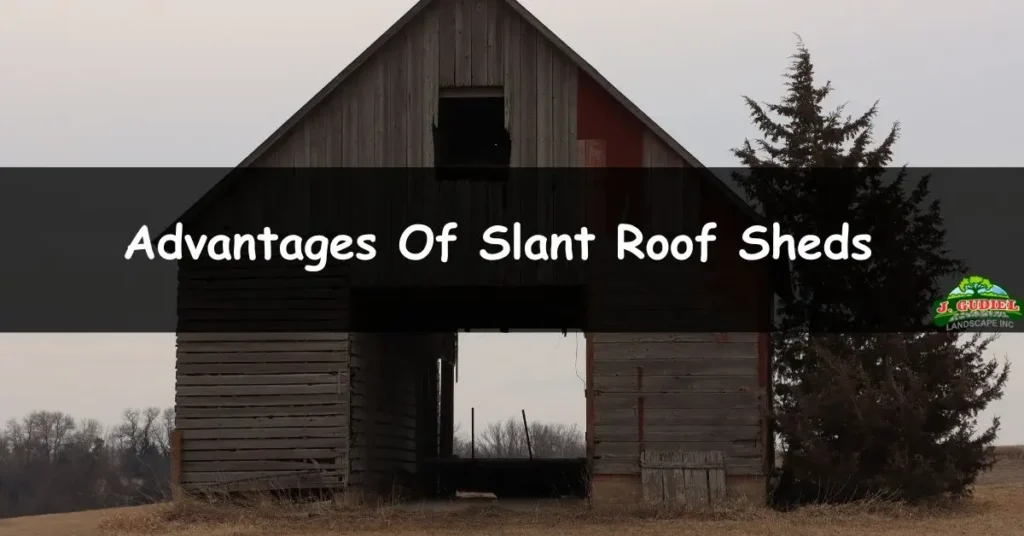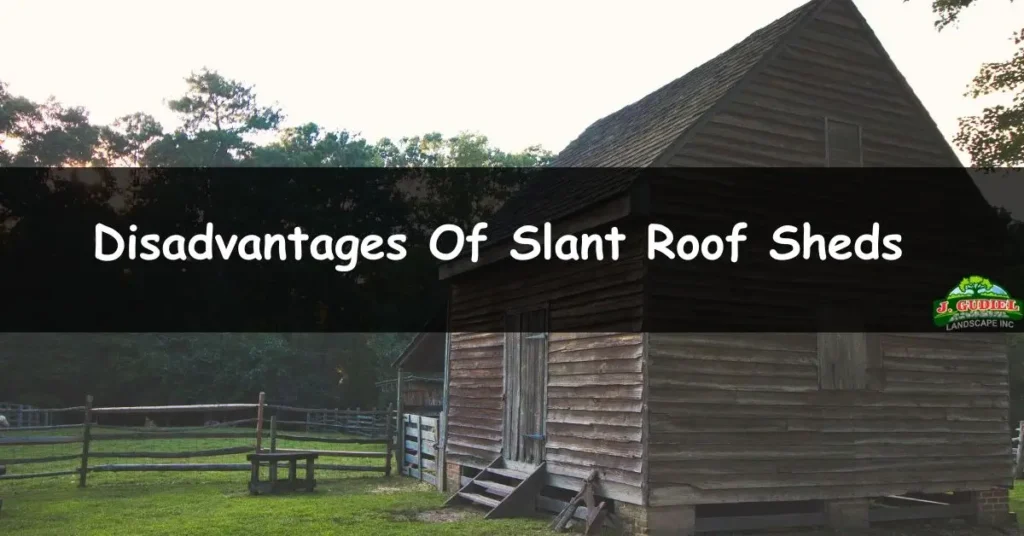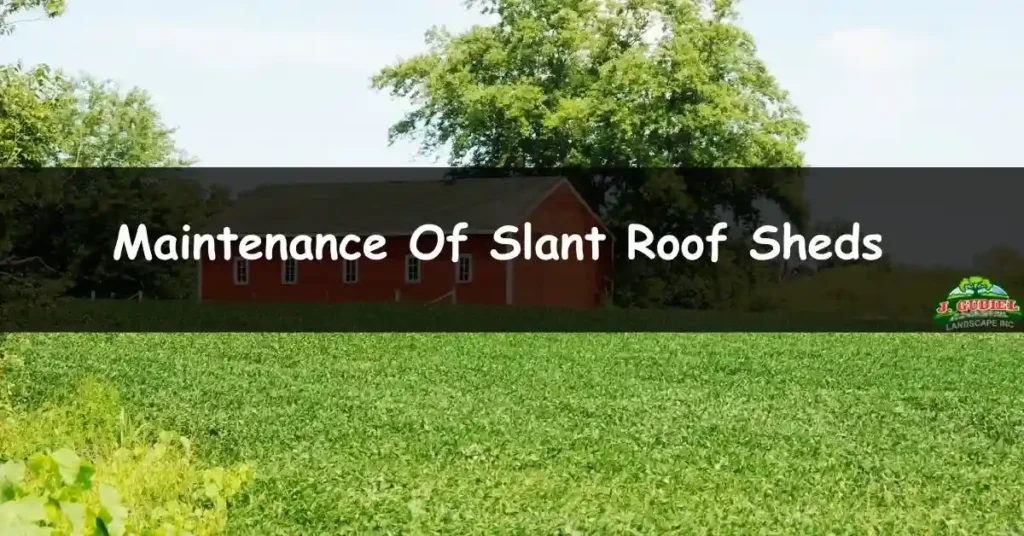Slant-roof sheds, also called mono-pitch or lean-to sheds, are popular for good reason. Their design offers exceptional flexibility, reliability, and functionality, making them a practical choice for various needs. Now that we’ve covered the basics, let’s get into the details!
What Is a Slant-Roof Shed?
A slant-roof shed is a building with a single-sloped roof. Commonly attached to a building, it can be used as a storeroom, where you can store equipment like tools and other things. Apart from being one of the most popular shed types, slant-roof sheds have many uses; from storing your gardening equipment to keeping your bike safe, a slant-roof shed can be helpful to everybody!
Advantages Of Slant Roof Sheds

Here are the popular advantages of slant roof sheds
Efficient Drainage
The sloped design of a slant-roof shed ensures efficient drainage of rainwater, snow, and debris, reducing the risk of water damage and extending the lifespan of the shed. This feature is particularly beneficial in areas susceptible to heavy rainfall or snow accumulation.
Increased Headroom
With its sloped roof, a slant-roof shed provides increased headroom near the front, allowing for more effortless movement and storage of tall items. This makes accessing tools, equipment, and other stored items suitable without feeling cramped.
Versatile Use
Slant-roof sheds are incredibly flexible and can serve various purposes beyond simple storage. They can be used as workshops, hobby spaces, gardening sheds, or small office spaces. Their compact size makes them suitable for placement in backyard gardens, alongside yards, or even on rooftops of more significant buildings.
Space Optimization
The roof’s slanted design maximizes the shed’s usable space while minimizing its overall footprint. This makes slant-roof sheds an excellent choice for properties with limited space or where zoning regulations restrict the Shed size of outbuildings.
Easy Construction
Slant-roof sheds are relatively simple to construct, requiring basic carpentry skills and tools. The straightforward design involves fewer complex angles and cuts than other roof styles, making it an accessible DIY project for homeowners. Additionally, if attached to an existing building, it can share a wall for support, further simplifying construction.
Affordability
One of the significant advantages of slant-roof sheds is their cost-effectiveness. They require few materials and less labor than sheds with more complex roof designs. Additionally, utilizing an existing structure for support can further reduce construction costs.
Weather Resistance
Slant-roof sheds are designed to resist multiple weather conditions effectively. The single-sloped roof allows rain and snow to run off quickly, preventing water buildup and minimizing the risk of leaks and moisture-related issues. Properly constructed slant-roof sheds can provide reliable protection for stored items year-round.
Aesthetic Appeal
Beyond their functional benefits, slant-roof sheds offer a unique and modern aesthetic that can enhance the visual appeal of any property. Their clean lines and modern design make them an attractive addition to traditional and present landscapes. With the right choice of materials and finishes, a slant-roof shed can complement the architectural style of the main building while adding character to the outdoor space. Discover how hardscaping can further elevate your property’s design and functionality.
Disadvantages Of Slant Roof Sheds

Here are some disadvantages of slant roof sheds
Limited Headroom
The limited headroom towards the back of the shed may restrict the activities that can be comfortably performed in that area. Taller individuals may find it challenging to navigate the space without bending, and storing more oversized items such as ladders or tall gardening tools may require creative solutions to optimize space usage.
Reduced Storage Capacity
Their sloped roof design may result in less vertical storage space compared to sheds with higher peak roofs. This could limit the types and quantities of items stored within the shed, notably taller or oversized items that require vertical clearance.
Aesthetic Limitations
While some people appreciate slant roof sheds’ modern and unique aesthetic, others may prefer more traditional or visually appealing shed designs. The V-shaped and disproportional appearance of slant roofs may not complement certain architectural styles or J Gudiel landscaping themes, potentially detracting from the property’s overall aesthetics.
Construction Challenges
Building a slant roof shed requires careful attention to ensure proper drainage, sealing, and integration with existing structures. Achieving adequate slope for effective water runoff, sealing edges and seams to prevent leaks, and properly connecting the shed to adjacent buildings can pose challenges during construction, requiring skilled labor and specialized techniques.
Limited Use as Living Space
The sloped design and limited headroom of slant roof sheds may make them unsuitable for conversion into habitable living spaces, such as home offices, guest rooms, or recreational areas. The lack of sufficient vertical space and insulation may compromise comfort and functionality for prolonged occupancy.
Potential for Leaks
While effective for drainage, the sloped design of slant roof sheds may also pose a risk of leaks if not properly installed or maintained. Factors such as insufficient sealing, aging roofing materials, or damage from external elements could lead to water infiltration and potential damage to stored items. Regular inspection and maintenance are necessary to address potential weak points and ensure long-term protection against leaks.
Impact on Property Value
Slant roof sheds may have less impact on property value than sheds with more visually appealing designs. Potential buyers may perceive them as less desirable or versatile, affecting property resale value or marketability.
Maintenance Requirements
Slant roofs may require more frequent maintenance than other roof styles to ensure proper drainage and prevent leaks. Regular inspection, cleaning of gutters and drainage systems, and timely repairs of any damaged or deteriorating roofing materials are essential to prolong the lifespan of the shed and protect stored items from water damage.
Cost Considerations
While they can be cost-effective in construction materials, their unique design and potential for specialized installation may incur additional costs compared to standard shed designs. Factors such as site preparation, drainage considerations, and integration with existing structures can contribute to overall construction expenses. Additionally, ongoing maintenance costs should be considered when assessing their long-term affordability.
Maintenance Of Slant Roof Sheds

Proper maintenance of a slant roof shed ensures its longevity, functionality, and aesthetic appeal. Regular upkeep helps prevent damage and extends the life of your shed. Here’s a how to keep your slant roof shed in top condition.
Inspect Regularly
Perform routine inspections of your shed, checking for any signs of damage, such as cracks, leaks, or loose components. Addressing issues early can prevent further damage and costly repairs.
Clean Gutters
Keep gutters and downspouts clear of debris to ensure proper drainage. Clogged gutters can lead to water buildup on the roof, increasing the risk of leaks and water damage.
Seal Edges and Seams
Periodically inspect and reseal any edges, seams, or joints where water could penetrate. A high-quality sealant for outdoor use is used to prevent leaks and moisture infiltration.
Check Roofing Materials
Inspect the condition of the roofing materials, such as shingles or metal panels, for signs of wear, damage, or deterioration. Replace any damaged or missing materials to maintain the integrity of the roof.
Trim Surrounding Vegetation
Trim back any overhanging branches or vegetation near the shed to prevent debris accumulation on the roof and minimize the risk of damage from falling limbs.
Address Pest Control
Prevent pests, such as rodents or insects, from infesting the shed. Seal gaps or openings where pests could enter and consider using traps or deterrents as needed.
Ventilation Maintenance
Ensure proper ventilation in the shed to prevent moisture buildup and mold growth. Clean and inspect vents and windows regularly to ensure they are functioning correctly.
Paint or Stain Exterior
Protect the shed’s exterior from the elements by applying a fresh paint or stain. This enhances the appearance and helps seal and protect the wood from moisture damage.
Secure Foundation
Check the foundation of the shed for any signs of shifting or settling. Make any necessary repairs to maintain the structural integrity of the shed and prevent water infiltration.
Winterization
Prepare the shed for winter by insulating pipes, sealing gaps, and ensuring proper drainage to prevent freezing and water damage during cold weather.
By following these maintenance tips regularly, you can ensure that your slant-roof shed remains in excellent condition and continues to serve its purpose for many years.
Conclusion:
Now you know everything you need to know about slant-roof sheds. They provide efficient outdoor storage solutions with adequate drainage, increased headroom, and compact footprint. While they may have limitations such as reduced storage capacity and aesthetic considerations, regular maintenance can mitigate these issues. Overall, slant-roof sheds offer an affordable, functional, and aesthetically pleasing option for homeowners, but they’re just one of many storage solutions available. If you’re weighing your options, comparing sheds vs. storage units can help you make the best choice for your needs.
FAQs
Q: What is a slant roof shed?
A: A slant roof shed is a type of outdoor structure with a sloped roof that allows rain and snow to slide off easily. It’s commonly used for storing tools, equipment, and other items in a backyard or garden.
Q: How do slant roof sheds work?
A: Slant roof sheds have a tilted roof that helps water and snow run off, preventing damage and leaks. This design also provides more headroom near the front for easier access to stored items.
Q: Are slant roof sheds easy to build?
A: Yes, slant roof sheds are relatively simple to construct with basic carpentry skills and tools. The straightforward design involves fewer complex angles and cuts compared to other roof styles, making it a manageable DIY project for many homeowners.
Q: What are the benefits of slant roof sheds?
A: Slant roof sheds offer efficient drainage, increased headroom, and versatile use for various storage needs. They’re cost-effective, space-saving, and can enhance the visual appeal of outdoor spaces.

